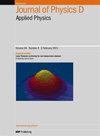Label-free characterization of pathological changes in the portal area of liver fibrosis tissue using multiphoton imaging and quantitative image analysis
IF 3.2
3区 物理与天体物理
Q2 PHYSICS, APPLIED
引用次数: 0
Abstract
Liver fibrosis plays a crucial role in the progression of liver diseases and serves as a pivotal stage leading to the development of liver cirrhosis and cancer. It typically initiates from portal area with various pathological characteristics. In this article, we employed multiphoton microscopy (MPM) to characterize the pathological changes in the portal areas of liver fibrosis tissues, and subsequently, we used our developed image analysis method to extract eight collagen morphological features from MPM images and also combined a deep learning method with a cell nuclear feature extraction algorithm to perform automatic nuclei segmentation and quantitative analysis in the H&E-stained histopathology images of portal areas. Our results demonstrate that MPM can effectively identify various pathological features in portal areas, and there are significant differences in four collagen features (collagen proportionate area, number, length and width) between normal and abnormal portal areas and in four nuclear features (mean ratio of axial length, disorder of distance to 3, 5 and 7 nearest neighbors) between normal portal area, bile duct hyperplasia and periductal fibrosis. Therefore, a combination of MPM and image-based quantitative analysis may be considered as a rapid and effective means to monitor histopathological changes in portal area and offer new insights into liver fibrosis.利用多光子成像和定量图像分析对肝纤维化组织门区病理变化进行无标记表征
肝纤维化在肝病的发展过程中起着至关重要的作用,是导致肝硬化和肝癌的关键阶段。肝纤维化通常从肝门区开始,具有各种病理特征。本文采用多光子显微镜(MPM)来表征肝纤维化组织门静脉区的病理变化,随后利用我们开发的图像分析方法从MPM图像中提取了8个胶原蛋白形态特征,并结合深度学习方法和细胞核特征提取算法,对H&E染色的门静脉区组织病理图像进行了细胞核自动分割和定量分析。结果表明,MPM 能有效识别门静脉区的各种病理特征,正常门静脉区和异常门静脉区之间的四个胶原特征(胶原比例面积、数量、长度和宽度)以及正常门静脉区、胆管增生和导管周围纤维化之间的四个细胞核特征(轴向长度的平均比值、与 3、5 和 7 个近邻的距离无序度)存在显著差异。因此,将 MPM 与基于图像的定量分析相结合,可被视为监测门静脉区组织病理学变化的一种快速而有效的方法,并为了解肝纤维化提供了新的视角。
本文章由计算机程序翻译,如有差异,请以英文原文为准。
求助全文
约1分钟内获得全文
求助全文
来源期刊
CiteScore
6.80
自引率
8.80%
发文量
835
审稿时长
2.1 months
期刊介绍:
This journal is concerned with all aspects of applied physics research, from biophysics, magnetism, plasmas and semiconductors to the structure and properties of matter.

 求助内容:
求助内容: 应助结果提醒方式:
应助结果提醒方式:


